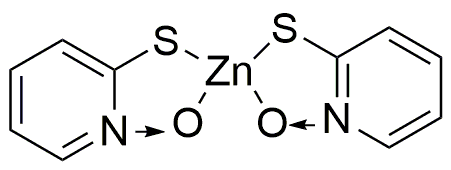2-Mercaptopyridine N-oxide zinc salt is widely utilized in research focused on:
- Pharmaceutical Development: This compound serves as a key intermediate in synthesizing various pharmaceuticals, particularly those targeting neurological disorders, due to its ability to interact with biological systems effectively.
- Analytical Chemistry: It is employed as a reagent in analytical methods for detecting heavy metals, providing a reliable means for environmental monitoring and ensuring compliance with safety regulations.
- Agricultural Applications: The compound is used in formulating pesticides and fungicides, enhancing crop protection while minimizing environmental impact compared to traditional chemicals.
- Material Science: It is incorporated into the development of advanced materials, such as coatings and polymers, that require enhanced durability and resistance to corrosion.
- Biochemical Research: Researchers utilize this compound in studies involving enzyme inhibition and metal ion interactions, contributing to a better understanding of biochemical pathways and potential therapeutic targets.
General Information
Properties
Safety and Regulations
Applications
2-Mercaptopyridine N-oxide zinc salt is widely utilized in research focused on:
- Pharmaceutical Development: This compound serves as a key intermediate in synthesizing various pharmaceuticals, particularly those targeting neurological disorders, due to its ability to interact with biological systems effectively.
- Analytical Chemistry: It is employed as a reagent in analytical methods for detecting heavy metals, providing a reliable means for environmental monitoring and ensuring compliance with safety regulations.
- Agricultural Applications: The compound is used in formulating pesticides and fungicides, enhancing crop protection while minimizing environmental impact compared to traditional chemicals.
- Material Science: It is incorporated into the development of advanced materials, such as coatings and polymers, that require enhanced durability and resistance to corrosion.
- Biochemical Research: Researchers utilize this compound in studies involving enzyme inhibition and metal ion interactions, contributing to a better understanding of biochemical pathways and potential therapeutic targets.
Documents
Safety Data Sheets (SDS)
The SDS provides comprehensive safety information on handling, storage, and disposal of the product.
Product Specification (PS)
The PS provides a comprehensive breakdown of the product’s properties, including chemical composition, physical state, purity, and storage requirements. It also details acceptable quality ranges and the product's intended applications.
Certificates of Analysis (COA)
Search for Certificates of Analysis (COA) by entering the products Lot Number. Lot and Batch Numbers can be found on a product’s label following the words ‘Lot’ or ‘Batch’.
*Catalog Number
*Lot Number
Certificates Of Origin (COO)
This COO confirms the country where the product was manufactured, and also details the materials and components used in it and whether it is derived from natural, synthetic, or other specific sources. This certificate may be required for customs, trade, and regulatory compliance.
*Catalog Number
*Lot Number
Safety Data Sheets (SDS)
The SDS provides comprehensive safety information on handling, storage, and disposal of the product.
DownloadProduct Specification (PS)
The PS provides a comprehensive breakdown of the product’s properties, including chemical composition, physical state, purity, and storage requirements. It also details acceptable quality ranges and the product's intended applications.
DownloadCertificates of Analysis (COA)
Search for Certificates of Analysis (COA) by entering the products Lot Number. Lot and Batch Numbers can be found on a product’s label following the words ‘Lot’ or ‘Batch’.
*Catalog Number
*Lot Number
Certificates Of Origin (COO)
This COO confirms the country where the product was manufactured, and also details the materials and components used in it and whether it is derived from natural, synthetic, or other specific sources. This certificate may be required for customs, trade, and regulatory compliance.

